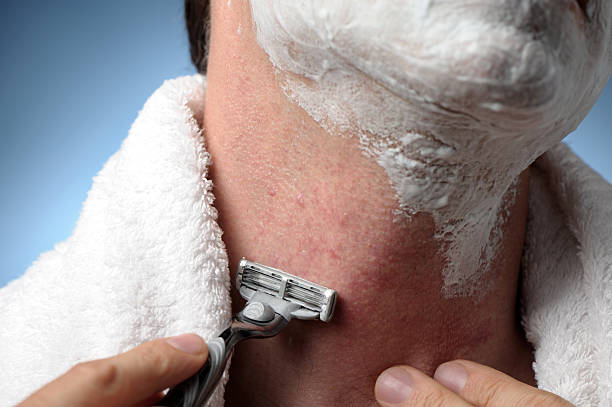
If you’ve ever experienced the discomfort of razor burn after shaving, you know how frustrating and irritating it can be. Razor burn can cause redness, itching, and other unpleasant symptoms that leave you feeling less than your best.
Table Of Contents
−- How Long Does Razor Burn Last On Face?
- What Causes Razor Burn?
- Symptoms of Razor Burn
- How Can I Prevent Razor Burn?
- What Is the Best Way to Treat Razor Burn?
- When Should I See a Doctor for My Razor Burn?
- What Are Some Over-the-Counter Treatments for Razor Burn?
- What Natural Oils and Butters To Use After Shaving
- What Are Prescription Medications There For Severe Cases of Razor Burns?
- How to Avoid Further Irritation with Shaving Products
- Skincare Tips After Shaving to Help Limit Symptoms of Razor Burns
- Is There Anything Else I Can Do To Reduce The Duration Of My Razor Burns?
- Conclusion
As a trusted source for shaving tips and skincare advice, Shaven Theory is here to help you understand how long razor burn can last on your face and provide practical solutions to treat and prevent it. Let’s dive into the details and find relief for your skin!
How Long Does Razor Burn Last On Face?
Razor burn is a common form of skin irritation caused by shaving. Its severity can range from mild to intense, with symptoms lasting from a few hours to several days. The duration of razor burn depends on the severity of the irritation:
- Mild Razor Burns: Typically clear up within a few hours
- Severe Razor Burns: May take up to 2-3 days to resolve
What Causes Razor Burn?
Razor burn can be caused by various factors, including shaving too close to the skin, using a dull razor blade, shaving dry skin, and shaving against the grain. Keep in mind that facial skin is delicate and prone to irritation, so it’s essential to take extra care while shaving.
Shaving too close to the skin
Shaving too closely can lead to razor burns, redness, inflammation, itching, and bumps. This happens when the skin’s lipid barrier is damaged, requiring several days to heal.
Using a dull razor blade
A dull blade causes friction, leading to irritation and redness. It can also tug at the skin, resulting in bumps or pimples. The discomfort of razor burn can be exacerbated by a dull blade scraping the skin.
Shaving dry skin
Dry skin is more susceptible to razor burn due to a lack of moisture. Those with sensitive skin may find it especially challenging to handle the friction from a razor blade.
Shaving against the grain
Shaving against the direction of hair growth can intensify the shave and increase the likelihood of razor burn.
Symptoms of Razor Burn
Razor burn often presents as a burning sensation, redness, and irritation. Some individuals may also experience raised bumps, pimples, itching, and stinging.
How Can I Prevent Razor Burn?
To prevent razor burn, it’s important to understand its causes and avoid triggers. Here are some helpful tips:
- Use a sharp razor: Replace dull blades frequently to minimize irritation.
- Take your time when shaving: Rushing can lead to razor burn. Shave slowly and carefully to avoid cutting the skin too deeply.
- Shave with the grain: Shaving in the direction of hair growth reduces irritation and the risk of razor burn.
- Use shaving cream or gel: These products create a protective barrier between your skin and the razor, helping to minimize irritation.
- Rinse with cold water: After shaving, rinse your skin with cold water to close the pores and reduce irritation.
- Moisturize: Keep your skin hydrated and moisturized to shorten the duration of razor burn symptoms and prevent recurrence.
What Is the Best Way to Treat Razor Burn?
To treat razor burn, focus on reducing inflammation and soothing the skin:
- Apply a cool compress or cold cloth: This helps reduce inflammation and discomfort.
- Use aloe vera gel: Aloe vera soothes, cools, and moisturizes the skin.
- Keep the area clean: Cleanliness prevents further irritation and potential infection.
- Use hydrocortisone cream: Over-the-counter hydrocortisone creams may reduce inflammation and itching. Use for a few days only, as long-term use can cause skin thinning.
- Consult your doctor: For severe razor burn, your doctor may prescribe antibiotic cream or oral antibiotics to clear up infection.
- Try witch hazel: Witch hazel contains tannins that reduce inflammation and irritation.
- Use natural oils and butters: Coconut oil, shea butter, and cocoa butter soothe the skin after shaving.
When Should I See a Doctor for My Razor Burn?
Seek medical attention if your razor burn is severe, lasts longer than a few days, is accompanied by other symptoms, or if you have painful or infected razor bumps. A dermatologist can provide advice on treating razor burn, identifying underlying causes, and may recommend laser hair removal as an alternative to shaving.
What Are Some Over-the-Counter Treatments for Razor Burn?
Effective over-the-counter treatments for razor burn include aftershave lotions and gels, aloe vera gel, cooling agents (menthol or camphor), and hydrocortisone products. These soothe and protect the skin while reducing redness, inflammation, and razor bumps. However, proper shaving techniques are essential for optimal results.
What Natural Oils and Butters To Use After Shaving
Natural oils and butters are excellent for soothing skin post-shaving:
- Shea butter: Contains vitamins and fatty acids that heal the skin.
- Aloe vera: Beneficial for treating razor burn; can be applied directly or added to aftershave lotion.
- Bentonite clay: Reduces inflammation and irritation.
- Essential oils (lavender, chamomile, tea tree): Anti-inflammatory properties calm the skin.
Combine with a base like coconut or almond oil for an aftershave lotion that reduces inflammation and moisturizes the skin.
What Are Prescription Medications There For Severe Cases of Razor Burns?
For severe cases, prescription medications like topical antibiotics, corticosteroids, and retinoids may be necessary. Antibiotics clear infection and reduce inflammation, corticosteroids reduce itching and swelling, and retinoids promote healing. Consult your doctor before using these medications due to potential side effects.
How to Avoid Further Irritation with Shaving Products
Choose shaving products carefully to avoid further irritation:
- Shaving cream for sensitive skin: Look for calming and soothing ingredients like aloe vera, jojoba oil, shea butter, and coconut oil.
- Sharp razor: Use a sharp razor to minimize skin damage and irritation.
Skincare Tips After Shaving to Help Limit Symptoms of Razor Burns
After shaving, follow these skincare tips to limit razor burn symptoms:
- Stay hydrated and moisturized: Proper hydration and moisturization keep your skin healthy and resilient.
- Use antiseptic on your razor: Pre-treat your razor with an antiseptic before and after each shave to reduce the risk of infection.
- Avoid extreme temperatures: Don’t use anything too hot or cold on the area, as this can further irritate the skin.
- Use a gentle, fragrance-free moisturizer: This helps soothe and calm the skin after shaving.
Is There Anything Else I Can Do To Reduce The Duration Of My Razor Burns?
While razor burn typically resolves on its own, you can take steps to reduce its duration:
- Use a sharp razor: A dull blade is more likely to cause razor burn, so always use a sharp razor.
- Apply aloe vera or witch hazel: These natural remedies have soothing and anti-inflammatory properties that can help alleviate symptoms.
- Avoid irritants: Steer clear of products that contain harsh chemicals or fragrances, as they can aggravate razor burn.
- Don’t scratch or pick: Scratching or picking at razor burn can worsen the condition and increase the risk of infection.
Conclusion
Razor burn is a common but manageable skin condition. By understanding its causes, symptoms, and treatments, you can reduce its impact on your daily life. Whether you’re seeking preventative measures or relief from existing razor burn, the tips and advice in this article can help you achieve smooth, comfortable skin after shaving. Remember, if your razor burn is severe or persistent, don’t hesitate to seek medical advice. Thank you for choosing Shaven Theory as your trusted resource for shaving and skincare knowledge. Here’s to your skin’s health and comfort!
Last update on 2024-04-26 / Affiliate links / Images from Amazon Product Advertising API
Affiliate Disclosure: This post contains affiliate links, which means I may receive a small commission, at no extra cost to you, if you make a purchase using these links.

Jay Kang
Just because i'm asian does not mean I don't need shaving. I always wanted to grow a beard when I was young, now I need to shave because hair growth for me is a problem. I'm going through what every man will and has gone through before.





